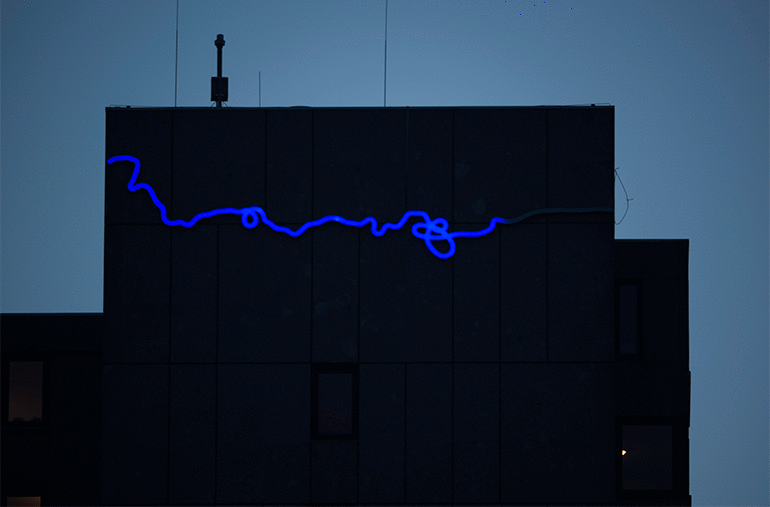 The End of the Signature, Agnieszka Kurant, 2014, visualisation of the installation in the for m of a neon, photo courtesy of the artist
The End of the Signature, Agnieszka Kurant, 2014, visualisation of the installation in the for m of a neon, photo courtesy of the artistIn June 2015 a neon by Agnieszka Kurant composed of thousands of visitors’ signatures will shine on one of the most famous buildings in the world.
The End of the Signature by Agnieszka Kurant is a work blending signatures by thousands of visitors of the Guggenheim Museum in New York. The collected signatures will be converted into a single pattern through software created by the artist in cooperation with programmers. The collective signature created in this way will blink on the façade of the building in the form of a laser projection reminding a neon. It will imitate the act of writing as if the building were signed over and over again like a palimpsest by a gigantic, invisible hand.
The shape of the signature will evolve. Visitors to the museum will be able to write down their own signatures on blank pieces of paper which will be regularly scanned and added to the collective one.
The project is linked to my interest in hybrid authorship, the exploitation of collective consciousness and the accumulation of energy from the invisible workforce. I am interested in the end of the idea of creativity as an individual process, as well as the end of absolutisation and fetishisation of single authors, which have been brought about by the era of Wikipedia and crowdsourcing platforms. Along with the gradual disappearance of handwriting, which is being replaced by entering text on keyboards, tablets and smart phones, single authorship could be entirely substituted by collective consciousness, dependent on millions of people carrying out micro-tasks. Taken together they will lead to the creation of works based on the hybrid authorship of thousands of authors – says the artist in an interview with Culture.pl.
Such authorless works derived from the collective consciousness have already been created thousands of years ago. After all, both the Bible and mythology relied on the oral transmission of stories, which were subject to change in the process of their retelling. In her work, Kurant attempts to highlight creativity as a product of collective consciousness and complex, non-linear processes.
An Autopen machine installed inside the museum building will also form part of the work The End of the Signature. Autopen is an automaton built at the beginning of the XIX century for Thomas Jefferson, among others – the third president of the United States and one of the authors of the US Declaration of Independence. The machine allowed the president to write a great amount of handwritten signatures. In Agnieszka Kurant’s work, the arm of the Autopen machine will create an unlimited number of fully identical collective signatures on blank pieces of paper.
 Agnieszka Kurant, The End of the Signature, (detail, Autopen machine), photo: courtesy of the artist and Tanya Bonakdar Gallery in New York
Agnieszka Kurant, The End of the Signature, (detail, Autopen machine), photo: courtesy of the artist and Tanya Bonakdar Gallery in New YorkThus, the installation refers to the idea of dispersed invisible power and the automation of people’s work – explains the artist.
Agnieszka Kurant is equally interested in the constantly changing identity of iconic urban buildings (such as the Guggenheim Museum designed by Frank Lloyd Wright). These buildings evolve continuously in the collective memory and consciousness of city dwellers regardless of the names and functions assigned to them by the authorities or architects.
In an actual or semantic way, inhabitants modify the identity of such icons in the context of uncontrolled processes of the collective consciousness.
The End of the Signature also refers to a note written by Marcel Duchamp in his notebook in 1916 – the idea of signing the Woolworth building in New York as ready made (a work of art created by an everyday object). The question of authorship is probably one of the parameters of art which Duchamp did not undermine nor deconstruct in his work. Even when using the pseudonym R. Mutt or Rose Selavy, Duchamp remained an individual and traditional author of this works in a fetishised way characteristic of modernism.